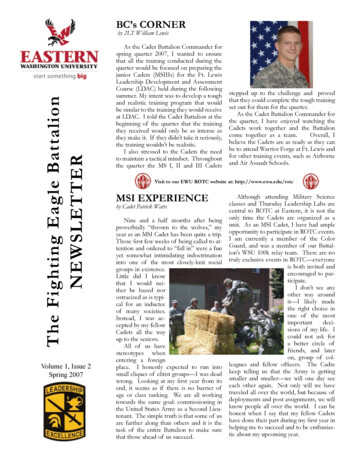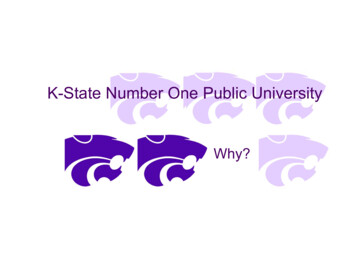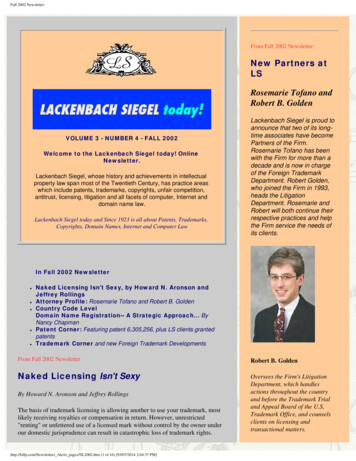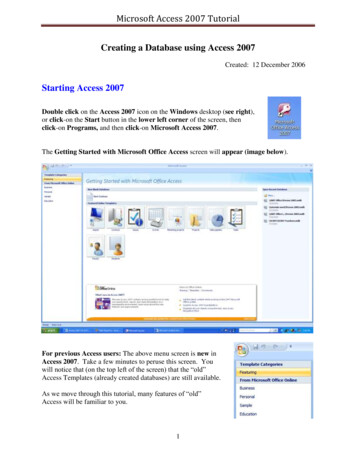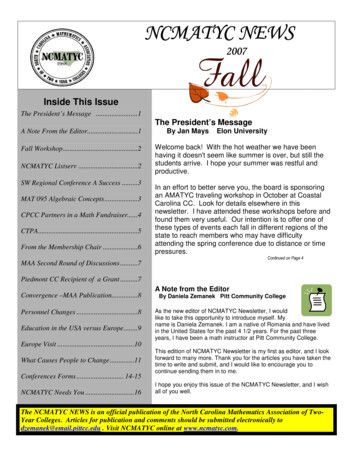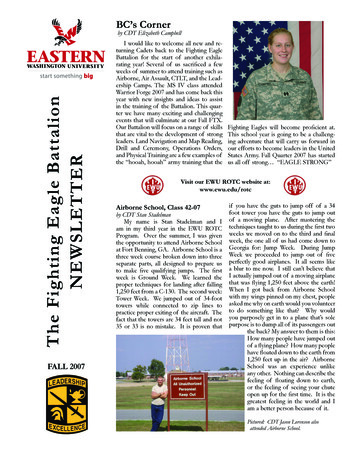
Transcription
BC’s CornerThe Fighting Eagle BattalionNEWSLETTERby CDT Elizabeth CampbellFALL 2007I would like to welcome all new and returning Cadets back to the Fighting EagleBattalion for the start of another exhilarating year! Several of us sacrificed a fewweeks of summer to attend training such asAirborne, Air Assault, CTLT, and the Leadership Camps. The MS IV class attendedWarrior Forge 2007 and has come back thisyear with new insights and ideas to assistin the training of the Battalion. This quarter we have many exciting and challengingevents that will culminate at our Fall FTX.Our Battalion will focus on a range of skillsthat are vital to the development of strongleaders. Land Navigation and Map Reading,Drill and Ceremony, Operations Orders,and Physical Training are a few examples ofthe “hooah, hooah” army training that theFighting Eagles will become proficient at.This school year is going to be a challenging adventure that will carry us forward inour efforts to become leaders in the UnitedStates Army. Fall Quarter 2007 has startedus all off strong “EAGLE STRONG”Visit our EWU ROTC website at:www.ewu.edu/rotcAirborne School, Class 42-07by CDT Stan StadelmanMy name is Stan Stadelman and Iam in my third year in the EWU ROTCProgram. Over the summer, I was giventhe opportunity to attend Airborne Schoolat Fort Benning, GA. Airborne School is athree week course broken down into threeseparate parts, all designed to prepare usto make five qualifying jumps. The firstweek is Ground Week. We learned theproper techniques for landing after falling1,250 feet from a C-130. The second week:Tower Week. We jumped out of 34-foottowers while connected to zip lines topractice proper exiting of the aircraft. Thefact that the towers are 34 feet tall and not35 or 33 is no mistake. It is proven thatif you have the guts to jump off of a 34foot tower you have the guts to jump outof a moving plane. After mastering thetechniques taught to us during the first twoweeks we moved on to the third and finalweek, the one all of us had come down toGeorgia for: Jump Week. During JumpWeek we proceeded to jump out of fiveperfectly good airplanes. It all seems likea blur to me now. I still can’t believe thatI actually jumped out of a moving airplanethat was flying 1,250 feet above the earth!When I got back from Airborne Schoolwith my wings pinned on my chest, peopleasked me why on earth would you volunteerto do something like that? Why wouldyou purposely get in to a plane that’s solepurpose is to dump all of its passengers outthe back? My answer to them is this:How many people have jumped outof a flying plane? How many peoplehave floated down to the earth from1,250 feet up in the air? AirborneSchool was an experience unlikeany other. Nothing can describe thefeeling of floating down to earth,or the feeling of seeing your chuteopen up for the first time. It is thegreatest feeling in the world and Iam a better person because of it.Pictured: CDT Jason Lorenson alsoattended Airborne School.
2007 Ranger Challenge at Corvallis, ORby CDT Blaine PowersThis year EWU ROTC assembled a team of 11 Cadets, whichincluded two alternates, to compete in Ranger Challenge 2007 heldat Oregon State University. Almost 20 cadets showed up to practiceduring the month before the competition, making it a competitiveselection process to earn the right to represent Eastern. Selected wereCadets Pat Watts, Jonathan Abshire, Jeremy Bermudez, Josh Decker,Phillip Figuerres, Veronica Neely, Aaron Peterson, Stephanie Hockettand Jason Lorenson. The team was led by captain Blair Powers.After an eight-hour bus ride, we arrived in Monmouth, OR andstarted the competition before dawn the next day with a Physical Fitness test. Three Cadets scored well into the extended scale while others broke their personal PT records. Cadet Veronica Neely earnedan astonishing 351 points, while Cadet Blaine Powers earned 326;both personal bests. Afterwards, the team moved on to the One RopeBridge completing the task in less than half the time it took the yearbefore; over 10 hours of practicing this event had paid off.Land Navigation followed and EWU took third. Cadets Pat Wattsand Blair Powers single handedly earned more points than some entire teams and when combined with the other Cadets from our team,our place was earned.Weapons assembly and disassembly followed suit, with Cadet Lorenson owning the event for the team. A hand grenade assault coursecame next allowing Cadet Abshire to hone skills he had learned thispast summer at Ft. Benning, GA. Cadets Peterson and Bermudezscored extremely well on the Map Reading Test. Overall, our teamhad a 95% average score on the test, the second highest score of thatcompetition.Sunday morning, while most competitors were sleeping, our teamcompeted in a 10K Forced Road March; the determining event inRanger Challenge. Cadet Decker traded in his camera from the dayprior for a rifle and a ruck to replace Cadet Bermudez who sufferedan ankle injury. Cadet Figuerres pushed through exhaustion and carried our guidon high, leading us to the finish line as one team. At theend of the day, the weeks of training and forfeited weekends hadpaid off.EWU placed fifth overall out of 11 teams. “Next year, firstplace is in our sight!”UPCOMING EVENTS1-2 MarchWinter Qtr FTX17-18 MaySpring Qtr FTX28 MarchWinter Qtr Commissioning29 MayNational Awards Ceremony20 AprilWSU 100K Relay Race13 JuneROTC Commissioning9 MayROTC Military Ball14 JuneEWU CommencementFor more information on any of these events, please contact our department secretaryat 509.359.2386 or by e-mail: ROTC@ewu.edu.Freshman Cadet Volunteerby CDT Katie ReidVolunteer work is always fun, rewarding and it gives you a chance to help out your local community. Thispast summer, I had the privilege of doing volunteer work in Matamoros, Mexico to help out the communityand experience life in Mexico. I got to do so much when I was down there. I got a chance to help out ata local orphanage and assist the children with their everyday tasks and chores. I also helped out at a localdump to assist homeless people collect garbage that they would later trade for money to buy food for theirfamilies. My crew and I did a lot of work in one neighborhood helping elderly people clean up their lawnsand repair their houses. We assisted in a community church in the neighborhood and lead VBS for the littlechildren during the day. Then held services and cooked dinner in the evenings.This trip gave me the opportunity to see how people in different cultures live and to see my religion atwork in that part of the world and in a different language. The knowledge and experience I gained while ina foreign country helped me to broaden my perspective on the world outside of suburban America.-2-
Branch ResultsBOLC III location in italicsCDT Erica BlockCDT Veronica NeeleyActive DutyArmy Nurse CorpsFt. Sam Houston, TXCDT Elizabeth CampbellActive DutyQuartermaster CorpsActive DutyMilitary Intelligence CorpsBranch detailedChemical CorpsFt. Leonard Wood, MOCDT Bryan O’DonnellFt. Lee, VACDT Amber EllisArmy Reserve/Nat’l GuardMedical Service CorpsFt. Sam Houston, TXCDT Levi FloeterArmy Reserve/National GuardMilitary Intelligence CorpsFt. Huachuca, AZCDT Nicholas PotterActive DutyMedical Service CorpsFt. Sam Houston, TXActive DutyInfantryCDT Erin PriestFt. Benning, GACDT Brian JohnstonActive DutyAdjutant General’s CorpsFt. Jackson, SCCDT James KoActive DutyAir Defense ArtilleryActive DutyMilitary Intelligence CorpsFt. Huachuca, AZCDT Stephen RobinsonActive DutyMilitary Intelligence CorpsBranch detailed InfantryFt. Benning, GACDT Richard SenklerFt. Bliss, TXCDT Tyler MayesActive DutyField ArtilleryThe Branching Experienceby CDT Erin Priest, XOBranching is a process that formally begins in our MSIII year andis for the most part the biggest thing that drives us to be our best.Which branch we receive is determined by where we end up on theOrder of Merit list, a list of rankings compiled after LDAC. Severalfactors go into where we end up on that list, a good GPA is themost important factor. Other factors include PT scores and overallperformance at LDAC. One of our assignments as an MSIII was topresent a branch profile to the class to aid us in figuring out whichbranch we think would suit us best. At LDAC, a day was set asidefor Branch Orientation at which we visited five branch stations ofour choice to get information on what it is like as an officer in thatbranch. Then, in the first week of our MS IV class our final listingof preferred branching, from number one to number sixteen, wassubmitted, and all we had left to do was wait. After nearly two weeksbeyond the date that branch results were supposed to be released,LTC Millet was sympathetic to our plight and took the time to haveus all gather in the classroom for a conference call from him whilehe was attending a conference in Nevada. So, crammed in the roomaround a table with the speakerphone on and weeks of anticipationculminating in those final moments, the mysteries of our destinieswithin the Army were finally revealed. Congratulations to all cadetswho received their branches, and good luck as your time at Easterncomes to an end!Active DutyMilitary Intelligence CorpsBranch detailed ArmorFt. Knox, KYFt. Sill, OKCDT Maxwell YardleyArmy ReserveSignal CorpsFt. Gordon, GACadet Troop Leadership Trainingby CDT Nicholas PotterWhen MAJ VanVleck told me I was selected to participate ina program called Cadet Troop Leadership Training (CTLT) afterROTC summer camp, I had only a vague idea of the three-weekprogram, but it sounded like fun. Cadets selected for CTLT are assigned to an active duty army unit. My orders were to report to Ft.Riley, KS, right after summer camp. From the airport at Kansas Citythere was a quick two-hour bus ride with 19 other Cadets. After being set up in base lodging, it was straight to work. I was to shadow LTGorgas and LT Bohn, leaders in Fox Company of the 1-41 Infantry,for the remainder of my time at Ft. Riley. I learned a lot from thosetwo over the next three weeks. I was able to sit in on meetings that included the Lieutenants, the Company Commander and the BattalionCommander. When not in meetings, I spent time at our motor poolwith LT Bohn working on training schedules and fixing the bumpernumbers on the tracked vehicles. When I was with LT Gorgas, weworked on getting enough materials to resupply our units. When Igot off work some of the other Cadets and I would run over to thegym or the swimming pool to get out of the 90-degree weather. Onother days the Lieutenants would take me downtown to Buffalo WildWings. Then, it would be an early bedtime so I could wake up for PTthe next day. I found the whole program to be a wonderful experience and would recommend it to other Cadets.ROTC My First Yearby CDT Joseph DeLongThere are many things that I have learned over the course of mylong and so far fruitful life, all 18 years worth. Most of the knowledgethat I have acquired I’ve gained in the past two years, thanks to themilitary. I enlisted at the age of 17. I’ve planned on coming to EasternWashington University and participate in ROTC since the beginningof my junior year of high school. I’ve been through basic training andbeen to AIT--ROTC is the next step in my military education. Thereis a great group of Cadets here at Eastern. I saw the MS IV branchceremony and it really put things in perspective for me. This programwill get me where I eventually want to be, in Military Intelligence. Isaw Cadets branch into Armor, Infantry, Artillery and the NursingCorps. It was pretty cool seeing Cadets in the same program I amin being accepted into the branches of their choice. This was ratherinspiring for me. These senior Cadets also serve as great mentors andexamples for MS III, II, and I’s. The ROTC program is also helpingme keep up with my physical fitness and academic standing. I hope tohave a successful four years here at Eastern and I must say that thisyear is off to a pretty good start.-3-
Fall FTXby CDT Nicholas Rose, NCOIC, Fall FTXFall quarter 2007 has come and gone. And, like always, at the endof each quarter, we take all of the skills learned and culminate theminto the mutual misery that we all share and come to love known asField Training Exercises (FTX). Fall FTX served as a benchmark forCadets to build upon because it implemented basic soldiering skillsand standards to the MS I’s and offered a refresher for experiencedCadets on highly perishable skills that may have been lost oversummer break.On Nov. 16, the MS III’s and IV’s loaded up their rucks andmoved out to good ole’ Camp Seven Mile. After setting up our ownpersonal luxurious “hooches” on the forest floor, we tried a newtwist to the same old night land navigation. A group would head outto a check point (CP) then, from there, each Cadet would branch offto find his/her point then come back to the CP to see if they hadfound the correct point and to receive another point to locate.Many Cadets found this to be a very useful method to conductnight land navigation for the first couple of times. I personallyenjoyed it because it allowed me to refresh my dead reckoning skillswithout being completely lost in the middle of nowhere.The following day the MS I’s and II’s showed up bright andearly to participate in the weekend’s activities, which consisted ofland navigation, land navigation, and land navigation, with a class onfield craft in between. Everyone received a healthy portion of landnavigation on Saturday, completing two-day iterations and a onenight iteration.On Sunday, Nov. 18, we particpated in practical exercises inindividual and squad movement techniques. This exercise provedto be a great learning experience for all Cadets. The MS I’s learnedthe basic movements used in the army, while MS II’s became moreproficient in their given tasks. As for MS III’s, we became familiarwith the concept of tactically moving a squad of troops from pointA to point B.The weekend adventure was a success and further improved theindividual soldiering skills within the battalion while improving unitcohesion and morale despite the occasional showers, cold weather,and MRE’s.Warrior Forge Summer 2007Leadership Training Courseby CDT Josie HallThe senior Cadets of the Fighting Eagle Battalion recentlyreturned from an intense 33-day training event held at beautiful Ft.Lewis, WA. This event, Warrior Forge, trained some 4,000 Cadetsthroughout 13 regiments last summer. Through the training Cadetswere taught basic and advanced skills necessary to become an Officerin today’s US Army. Training was broken into two main sections,garrison and field training. During garrison operations Cadets notonly participated in numerous training exercises but were also assessedon their leadership skills based upon 16 leadership dimensions. Themain focus of Warrior Forge is to assess Cadets by putting themin numerous leadership positions ranging from a Squad Leader, incharge of 10-12 Cadets, to the Commanding Officer of a Company,in charge of 150 – 200 Cadets. Training held in garrison operationsincluded basic rifle marksmanship, land navigation, physical training,confidence course, water survival and proper drill and ceremony. Onday 18 of training, Cadets move from the comfort of their WWIIbarracks to the dense vegetation of Ft. Lewis to engage in intensewar games throughout a 10-day period. Throughout this periodCadets are once again put in numerous leadership positions leadingtheir squads or platoons in a wide variety of battle drills. Thesedrills include recon, deliberate attack/ambush, knock out a bunker,and react to contact. To add to the excitement and to better trainthe Cadet’s decision making capabilities, variables were incorporatedinto the battle drills. These variables included: meetings with villageleaders, dealing with the media on the battle field, and negotiatingwith locals for mission critical information. The purpose of this 10day field training is to force the Cadets to grow as Leaders. Overall,it was a great experience and has prepared the MS IV’s to better leadthe Fighting Eagle Battalion throughout this school year.by CDT Nicole O’BrineThis summer I spent four weeks at Ft. Knox, KY attending theROTC Leadership Training Course (LTC). While there, I had theopportunity to meet Cadets from all across the country and engagein training that will add to my experience in ROTC. Each week wasfilled with new experiences that proved to be challenging and helpedus all grow as leaders.Week one was dedicated to teaching us the basics of military life.We learned everything from proper uniform wear to basic drill andceremony movements. Other tasks accomplished were an APFTand completing the ever so exciting “in-processing”.Week two was filled with weapons training, repelling, and combatwater survival tests similar to the ones we participate in at EWU.We also began participating in leadership roles in our respectiveplatoons, squads and teams.Week three focused on basic land navigation and squad movementtechniques and tactics. Time was also spent being mentored by2LT’s that were assigned to our squads, helping us gain very usefulknowledge of what life as a new 2LT is like, and helping us withpractical tips with our leadership dimensions.Week four we participated in a comprehensive FTX, thecapstone of our LTC experience. During the FTX we were requiredto remember and put to use all the training we had received duringthe past few weeks. Following the FTX we had a graduationceremony and out-processed.My experience at LTC left me better equipped and prepared asa ROTC Cadet. It gave me a firm foundation to build on during mytime in ROTC in preparation of serving as an United States ArmyOfficer.-4-
ALUMNI UPDATESJames M. Watanabe (1988)BG Scott G. West (1976)Served in WA Army National Guard until 1994. Went active duty,1st CD, Ft. Hood, TX as Chaplain. Left Army service in 1995.Currently, Chaplain for the Federal Bureau of Prisons at FCCBeaumont, TXServed as the J4, Multinational Force Iraq fromJul 2003-Jul 2004. Had the privilege of servingthere with COL Mike McCaffree who was, at thetime, the Deputy Cdr for the 81st Mech InfantryBrigade. Also served at Camp Victory in Baghdadwith MAJ (R) Chris Little. Photo was taken in Fall‘03. (Photo left to right: C. Little, S. West)MAJ Tyrone C Abero, SC (1992)OIF 1 - Currently OIF V, 63rd Expeditionary Signal Battalion, Balad/LSAAnaconda IraqMAJ (R) Christopher W. Little, FA (1985)CPT Kevin Bentz, AG (2001)OIF, May 2003-Jan 2004 1st Armored Division. Pictured duringsummer 2003 at Camp Victory, near the Al Faw PalaceDeployed MAY 2003 to JUL 2004 in supportof Operation Iraqi Freedom as an Air DefenseOfficer. Deployed as a platoon leader then becamethe Battery Executive Officer two months intodeployment. Served 12 months in Baghdad and anadditional three months in Al Kut. Was branchtransferred into AG and is stationed at Ft. Riley,KS. He is the S1 for the 125th Brigade SupportBattalion, 3 Heavy Brigade Combat Team, 1st Armored Division.COL (R) Albert J. Watson (1981)Retired from Army Reserves Sep 2005. Retired from Manufacturers SalesRepresentative position in 31 Dec 2007. Currently resides inVancouver, WA.COL George A. Abbott (1981)Photo: In front of the martyrs monument in downtown Baghdad.Deployed to Iraq as a member of the 81st Brigade, WA Army NationalGuard, 2004-5. He is currently an Armor Officer.CPT Thomas A. Gromus (2003)COL Earl D. Noble (1985)As LTC, was assigned as Product Manager for DefenseWide Transmission Systems. Nov 2003-Jul 2005 was responsible for communications projects in Afghanistan andIraq and travelled extensively throughout both countries.Currently director of the Future Combat System Dept ofthe Army coordinating office in the Pentagon. July 2008will assume command as Project Manager for AKO. Photo:2005 03 24 at Kabul AirportJun 03-Mar 04, IOBC, Fort Benning, GA; Mar 04-May 04, IN PL,FSC XO, FSC Company Commander Ft. Hood, TX, deployed toIraq, Nov 06-Nov. 07; May 07-Nov 07, Ft. Lee, VA, CombinedLogistics Captains Career Course; Nov 07-Present, Ft. Riley, TDYfor MiTT Training; Feb 08, will deploy to Iraq on a Battalion MiTTfor one year, assigned as S4/Log Trainer Advisor.CPT Joseph Marshall (2004)Currently 1BCT, 41D, III Corps, Ft. Hood, TXCPT John C. Pettibone (1986)His guard unit was activated for Desert Shield/Desert Storm in1990-91. Was active duty for six months with the 48th InfantryBrigade (Mech). Spent the war at the National Traning Center andstill holds the record for the longest NTC rotation. Also stationedat Ft. Stewart, GA.1LT Sean Force, IN (2005)2-2 SCR, currently in Baghdad.LTC David T. Knight, MI, USAF (1988)Has 19 years of service both active and reserve. In2000, transferred to the Air Force (“don’t hold itagainst me”). Currently assigned as Commanderof the 141st Security Forces Squadron (ANG)at Fairchild AFB, WA. Has deployed 12 timesto a variety of locations during the past 6 yearsHis unit has been responsible for transportingprisoners to and from Guantanamo Bay, Cuba,mostly out of Afghanistan. Just returned frommost recent deployment (pictured), which was to Incirlik AB Turkey andBalad Iraq. Recently picked up for LTC, and should pin sometime duringthe next couple of months.2LT William J. Fehrenbach, EN (2006)CPT (R) Melvin Jack Rothrock (1988)A Viet Nam vet who was drafted into the Army in 1970. His MOSwas 98C (Intel traffic analyst). Spent most of his time attached to1st Cav as an 81 mm mortar gunner. Later attended OCS and wascommissioned at Ft. Benning, GA as Intel Officer specializing inElectronic Warfare. Graduated from EWU with a MS degree on a2-year Army Grad School Scholarship.On Patrol in Iraq2LT Nicholas Charlton, SC (2007)BOLC III at Ft. Gordon, GA. First duty station at Ft. Hood TX,3rd Signal Brigade.DO YOU HAVE NEWS TO SHARE?Send us an e-mail at: ROTC@ewu.edu-5-
Football Season 2007Left to right:CDT Blair Powers, CDT Phillip Figurres,CDT Jarod Cutchin, LTC M. David Millet, ROTC PMS, CDT Robb Loeb, JimValentine, Cheney VFW, CDT TaborHeine, CDT Patrick Watts, CDT ElizabethCampbell, CDT Chris MacGeorge, CDTJason Lorenson, CDT Jeremy Bermudez,and CDT Blaine Powers.Note From the PMSby LTC M. David Millet (dmillet@ewu.edu)This is our third EWU ROTC newsletter and if you missed the first two they are posted on our website. Many of you willreceive this edition of the newsletter via e-mail as we try to limit our cost of publishing and mailing out hundreds of copies. Theprevious newsletters have reached hundreds of Alumni and parents and have expanded our alumni contact list two-fold. In thatregard, Cadet Command is working on a webpage called “ROTC Alumni Link,” similar to the West Point Alumni site, that willenable us to better connect to our past, present and future Fighting Eagle associates – stay tuned for further updates.I am proud of all the accomplishments of our Cadets over the Summer and Fall months. The MSIII Cadets we sent to Ft.Lewis, WA for Warrior Forge 07, performed in an outstanding manner – achieving or exceeding the Cadet Command averagesin all graded events. Two of our Cadets (Josi Hall and Brian Johnston) received the highest overall evaluations possible andCadet Chris MacGeorge received the prestigious RECONDO Badge. These Cadets are now the senior leaders of the CadetBattalion and quickly taken on the mantle of leadership by developing and implementing a solid training plan to start off thenew academic year.The Fighting Eagle Battalion continues to grow with over 70 Cadets currently in the program and, we project to commission16 new Second Lieutenants this academic year, which would be the highest number in many years. This is due to all the hardwork of the Cadets and Cadre who continue to recruit, retain and train the quality young men and women who are willing toserve their Country. Because of the expanding Army and need for more Officers, our Command has tasked Eastern to produceeven more Officers starting in 2010 – I know we are up to the challenge and appreciate your support and the complete supportof the entire Eastern Washington University staff and administration, and the community of Cheney.Please continue to spread the good word of our future Leaders and please share your alumni information with us – we enjoyseeing and sharing current photos of what our EWU ROTC alumni are up to today.Warrior Forge Summer 2007Pictured at right are some of the EWU ROTCparticipants at Warrior Forge 2007, held atFt. Lewis, WA.Left to right:CDT Tyler Mayes, Cheney WA; CDT James Ko,Mukilteo, WA; CDT Brian Johnston, Kennewick,WA; MAJ Kraig VanVleck, EWU ROTC APMS,CDT Richard Senkler, Hartline, WA; andCDT James Appel, Colfax, WA
Army Nurse Corps Ft. Sam Houston, TX CDT Elizabeth Campbell Active Duty Quartermaster Corps Ft. Lee, VA CDT Amber Ellis Army Reserve/Nat'l Guard Medical Service Corps Ft. Sam Houston, TX CDT Levi Floeter Active Duty Infantry Ft. Benning, GA CDT Brian Johnston Active Duty Adjutant General's Corps Ft. Jackson, SC CDT James Ko Active Duty Air .
